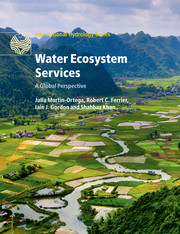Book contents
- Frontmatter
- Contents
- List of contributors
- Preface
- 1 Introduction
- 2 What defines ecosystem services-based approaches?
- Part I Addressing global challenges
- 3 Assessing climate change risks and prioritising adaptation options using a water ecosystem services-based approach
- 4 Operationalizing an ecosystem services-based approach for managing river biodiversity
- 5 Water for agriculture and energy: the African quest under the lenses of an ecosystem services-based approach
- Part II Applying frameworks for water management and biodiversity conservation under an ecosystem services-based approach
- Part III Assessing water ecosystem services
- Part IV Broadening the perspective
- Index
- Plate Section
- References
4 - Operationalizing an ecosystem services-based approach for managing river biodiversity
from Part I - Addressing global challenges
Published online by Cambridge University Press: 05 May 2015
- Frontmatter
- Contents
- List of contributors
- Preface
- 1 Introduction
- 2 What defines ecosystem services-based approaches?
- Part I Addressing global challenges
- 3 Assessing climate change risks and prioritising adaptation options using a water ecosystem services-based approach
- 4 Operationalizing an ecosystem services-based approach for managing river biodiversity
- 5 Water for agriculture and energy: the African quest under the lenses of an ecosystem services-based approach
- Part II Applying frameworks for water management and biodiversity conservation under an ecosystem services-based approach
- Part III Assessing water ecosystem services
- Part IV Broadening the perspective
- Index
- Plate Section
- References
Summary
4.1 INTRODUCTION
Covering less than 1% of the Earth's surface, freshwater – streams, rivers, ponds, wetlands, and lakes – supports as much as 10% of all animal species, including one-third of all vertebrates (Strayer & Dudgeon 2010; Figure 4.1). While being among the most biologically diverse, freshwater ecosystems are also among the most imperiled on the planet. In developed regions such as Europe and USA, more than 30% of freshwater species are now thought to be threatened or extinct. As with the majority of the world's ecosystems, accelerated rates of human population growth, industrialization, and agricultural intensification are driving these dramatic species losses, with invasive species introductions, over-harvesting, and loss of habitats being the primary causes (Dudgeon 2013).
Reducing freshwater biodiversity loss is at odds with managing many other ecosystem services. Much of the conflict lies in the fact that freshwaters are ‘hot spots’ for both human needs (i.e. drinking, irrigation, transportation) as well as biodiversity (i.e. the number or suite of species native to a given area; Strayer & Dudgeon 2010; Leisher, this book). Moreover, the majority of the world's population is facing, and will continue to face, increasing water scarcity (Vörösmarty et al. 2010). Humans rely heavily on freshwater, and in particular from large rivers for hydropower, transportation, and fisheries. Water abstraction further strains the integrity of a river's biophysical components, including biodiversity. While some aspects of freshwater ecosystem services are renewable (e.g. water supply), biodiversity is not.
This chapter seeks to clarify how ecosystem service-based approaches can be put into practice (‘operationalized’) for the purpose of prioritizing freshwater biodiversity alongside other river services. We propose a framework that is meant to serve as a way to explore trade-offs in ecosystem services delivery. We base this operationalization on three typical perspectives associated with freshwater biodiversity: inherent value as a final service, biodiversity–ecosystem function (an intermediate or provisioning service), and some combination of the two.
- Type
- Chapter
- Information
- Water Ecosystem ServicesA Global Perspective, pp. 26 - 34Publisher: Cambridge University PressPrint publication year: 2015
References
- 5
- Cited by

